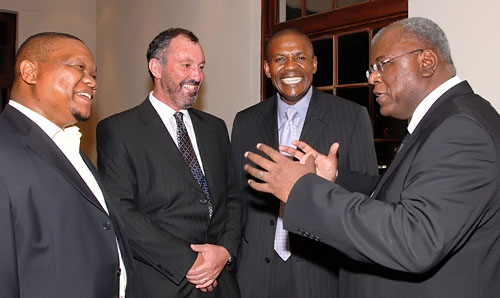 |
Attending the inauguration ceremony are, from the left: Mr Pule Makgoe, MEC for Education in the Free State and member of the UFS Council; Judge Ian van der Merwe, Chairperson of the UFS Council; Dr Khotso Mokhele, newly inaugurated Chancellor of the UFS; and Prof. Jonathan Jansen, Vice-Chancellor and Rector of the UFS.
Photo: Dries Myburgh |
Dr Khotso Mokhele joined the ranks of distinguished Chancellors of the University of the Free State (UFS) with his inauguration as the new Chancellor of the institution at a ceremony on Friday, 19 November 2010.
The lustrous ceremony took place on the Main Campus in Bloemfontein and was attended by hundreds of guests from all over South Africa.
Dr Mokhele said in his speech: “I am excited to have been invited by the UFS to join its community at the time when it is attempting to reinvent itself into an institution that will be counted amongst those that will shape the local, regional, national will, and by so doing, contribute to the shaping of an African will.”
Dr Mokhele follows in the footsteps of Dr Franklin Sonn, former Ambassador of South Africa in the United States of America and receiver of many awards, acknowledgements, and honorary doctorates, who retired earlier this year. Dr Sonn was preceded by Ms Winkie Direko, former premier of the Free State.
His acceptance of the role of Chancellor is a great honour for the UFS.
According to Prof. Jonathan Jansen, Vice-Chancellor and Rector of the UFS, it is a proud moment to welcome someone from the Province as the Chancellor of this university. With his strong academic values and deep sense of human compassion, Dr Mokhele is one of but a few uncompromising leaders. He is also an inspiring, determined pioneer and a role model to all our students.
Few have done as much to guide the development of science in South Africa since democracy in 1994 as Dr Mokhele. His vision and actions as a senior science manager have been guided by his deep conviction that for a truly democratic society to emerge in South Africa all people must be empowered to be its architects and must have unhindered access to those careers upon which our economy is built.
Dr Khotso Mokhele was born and raised in Bloemfontein. After matriculating from the Moroka High School he went on to study at Fort Hare, where he graduated with a B.Sc. in Agriculture, winning the Massey-Ferguson award for the best student in that field. As a recipient of the prestigious Fulbright-Hays Scholarship, he entered the University of California in Davis where he took a M.Sc. and a Ph.D. degree, both in Microbiology. He was awarded post-doctoral fellowships at the Johns Hopkins University School of Medicine in Baltimore, Maryland, and at the University of Pennsylvania, Philadelphia.
Dr Mokhele returned to South Africa in 1987, set on becoming a top-class academic and researcher. He held lecturing posts at the Universities of Fort Hare (1987-1989) and Cape Town (1990-1992). In 1992 he joined the Foundation for Research Development (FRD) as one of its Vice-Presidents. He succeeded to its presidency in 1996 and then from 1999 to 2006 became the first President of the National Research Foundation (NRF). He successfully merged the FRD and the Centre for Science Development of the Human Sciences Research Council. Under his visionary leadership the NRF has come to play a pivotal role in the development agenda of the country. He was also instrumental in the establishment of the South African Academy of Sciences serving as its founder president (1996-1998).
Dr Khotso Mokhele's contribution to science in South Africa has received wide recognition locally and abroad. He has received nine honorary doctorates. He was made a Chevalier of the Legion of Honour by the President of France in recognition of his personal efforts in strengthening scientific ties between France and South Africa, and was appointed a director of the Salzburg Seminar, an institution focused on global change, and subsequently a member of its Council of Senior Fellows.
He also serves on the boards of major companies such as Implats, Adcock Ingram and Afrox.
Media Release
Issued by: Lacea Loader
Director: Strategic Communication (actg)
Tel: 051 401 2584
Cell: 083 645 2454
E-mail: loaderl@ufs.ac.za19 November 2010